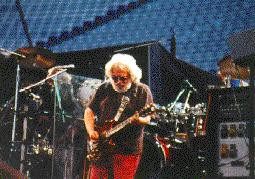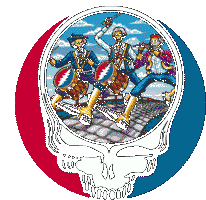Celebrating the last Grateful Dead show


Link to pictures of the last Grateful Dead concert
Long live the Dead
By BILL STRAUBScripps Howard News ServiceJuly 14, 2005
The date - July 9, 1995.
The place - Soldier Field, Chicago.
The Event - The closing date on yet another summer tour for The Grateful Dead, the legendary jam band, the pride of San Francisco, the idol of millions of self-described Deadheads, one of the few remaining legitimate cultural links to the Summer of Love, tie-dyed T-shirts, communal living, recreational drug use and a type of music that defied easy categorization.
It was a unique evening off the banks of Lake Michigan. The concert was sold out, of course, even though the band had been together for more than 30 years, beginning its existence as the Warlocks before Jerry Garcia, the beloved Captain Trips, plucked the name "Grateful Dead" out of a dictionary.
Garcia, with his regular guitar, Lightning Bolt, in the shop for repairs, started out the concert on Rosebud, a handmade instrument he first strapped on in 1990. When it developed technical problems, he turned to an old standby, Tiger, a 13-1/2-pound ax that served as his primary tool for 11 years with the band.
After a fairly mundane show, opening with "Touch of Grey," the band's lone hit single over three decades of work, and ending with the crowd-pleasing "Sugar Magnolia," the Dead surprised devotees by performing not one but two encores -"Black Muddy River" and, finally, "Box of Rain," a song co-written by bass player Phil Lesh for his dying father, with the final line, "Such a long, long time to be gone and a short time to be there."
The selection proved prophetic.
After an estimated 2,317 concerts in 298 cities, playing 36,086 songs, the Soldier Field show was the band's last. Shortly thereafter, Garcia checked himself into a drug-rehabilitation center to kick a persistent heroin habit. On Aug. 9, 1995, he was discovered dead in his bed at the Serenity Knolls clinic in Novato, Calif., at age 53, thus ending The Grateful Dead's long, strange trip.
Or did it? Since the band's demise, individual members have branched out on their own. Guitarist Bobby Weir continues to tour with Ratdog. Lesh recently wrote a book, "Searching for the Sound - My Life with the Grateful Dead."
Millions of dollars' worth of Dead merchandise continues to be sold over the Internet annually.
And the music never really stopped. Unlike most rock bands of the era, the Dead not only welcomed fans to tape their shows but encouraged it, setting up recording stations around concert venues. Literally dozens of live CDs have been released over the 10 years since the band's last appearance - including a glorious box set recorded at the closing of San Francisco's celebrated Winterland Ballroom on New Year's Eve 1978.
There are even DVDs. July 5 marked the release of "Grateful Dead Truckin' to Buffalo," filmed at Rich Stadium in Buffalo, N.Y., on the Fourth of July, 1989.
The Grateful Dead always was more than just your standard-issue rock 'n' roll band.
Indeed, starting with the original incarnation of Garcia, Weir, Lesh, keyboard and blues harp player Ron "Pigpen" McKernan and drummer Bill Kreutzmann, the band could prove better than Seconal for the sleep-deprived - they meandered away for more than 40 minutes on "Dark Star" at Civic Hall in Rotterdam, Netherlands, on May 11, 1972, for no apparent reason. But they never sold out, offering up a unique mix of blues, country, folk and rock, with a nod toward jazz-like improvisation, that no one else could match.
But beyond that, the Dead represented a real community for their devoted fans, known as Deadheads, who followed the band wherever it might lead. Tales about aficionados who left family, jobs and other responsibilities to follow the band are legion.
Some followed Garcia and the gang from city to city for years on end, begging for tickets and communing with others similarly inclined. Some cities banned the Dead from appearing because of the damage caused by Deadheads who lived in parks and on sidewalks and other types of public accommodations waiting for the band to arrive.
The tie between the Dead and its fans began around the mid-'60s - just as what was popularly described as the counterculture began to thrive - in the wake of the group's tenure as the house band for Ken Kesey's acid parties. The group's first show as the Grateful Dead came on Dec. 10, 1965, at a benefit for the San Francisco Mime Troupe that was organized by promoter Bill Graham, at Fillmore Auditorium.
After that, it wasn't an event around the San Francisco Bay Area if the Dead didn't show up for a free gig. On Jan. 14, 1967, it played for the Human Be-In, an early Vietnam War protest at Golden Gate Park, before 20,000 people. Band members and their extended family moved into a house at 710 Ashbury St. in the city's Haight-Ashbury district in September 1966, and the fun began.
The band recorded - "Workingman's Dead,'' "American Beauty'' and "Europe '72'' must be found in any serious collection - but Deadheads will insist until their own dying day that nothing matched the band in a live performance, with Garcia's guitar solos soaring and edging to the brink, only to be drawn back before disaster struck.
The Grateful Dead often was described as a psychedelic band, owing to what some viewed as a free-form style and a taste for LSD and other drugs that might be available. But the description is wide of the mark, and anyone who connected the band to hippies - this was San Francisco, after all - never really listened to their lyrics, mostly penned by Robert Hunter.
In "Jack Straw," one of their most popular tunes, Weir sang:
"Jack Straw from Wichita cut his buddy down
And dug for him a shallow grave and laid his body down
A half a mile from Tucson by the morning light
One man gone and another to go, my old buddy you're moving much too slow"
Pigpen died of liver failure on March 8, 1973, at age 27 - the first of three keyboard players to expire before their time. Drugs and alcohol rattled the band. Garcia suffered from diabetes.
But the band persevered for 30 years before Garcia's death 10 years ago. And the music lives on.



0 Comments:
Post a Comment
<< Home